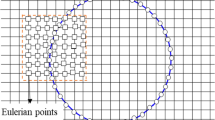Abstract
When a liquid droplet impacts on a solid surface, it recoils to the center of that surface after reaching its maximum spreading diameter. The mechanism of droplet recoiling is not fully understood. To simulate this recoiling of a droplet, a particle method is a good choice because it does not require grids for simulating fluid motions, and can easily handle a large deformation of fluid. In this study, the coupled method of rigid body dynamics and the moving particle semi-implicit (MPS) method (Park and Jeun, 2011) was used to calculate three-dimensional droplet impingement. Also, the previous surface tension model for MPS (Nomura et al., 2001) was revised to get a more realistic surface tension force. A two-step calculation was performed. In the first step, a MPS calculation was performed with particles that were considered to have no mass or volume. In the second step, rigid body dynamics came into the calculation and considered the diameters of particles being slightly lesser than the initial distance between particles. In this study, the calculated results were compared with the measured data (Kim and Chun, 2000) and the recoiling lengths of droplets for the various initial impingement speeds were estimated.
Similar content being viewed by others
References
L. Cheng, Dynamic spreading of drops impacting onto a solid surface, Ind. Eng. Chem. Process Des. Dev., 16 (1977) 192.
J. -P. Delplanque and R.H. Rangel, A comparison of models, numerical simulation, and experimental results in droplet deposition, Acta Materialia, 46(14) (1998) 4925–4933.
J. Fukai, Y. Shiiba, T. Yamamoto, O. Miyatake, D. Poulikakos, C. M. Megaridis and Z. Zhao, Wetting effects on the spreading of a liquid droplet colliding with a flat surface: Experiment and modeling, Phys. Fluids, 7 (1995) 236.
J. Fukai, Y. Shiiba, and O. Miyatake, Theoretical study of droplet impingement on a solid surface below the leidenfrost temperature, Int. J. Heat Mass Transf., 40 (1997) 2490.
M. Pasandideh-Fard, S. Qiao, S. Chandra and J. Mostaghimi, Capillary effects during droplet impact on a solid surface, Phys. Fluids, 8 (1996) 650.
M. Pasandideh-Fard, S. D. Aziz, S. Chandra and J. Mostaghimi, Cooling effectiveness of a water drop impinging on a hot surface, Int. J. Heat Fluid Flow, 22(2) (2001) 201–210.
S. Koshizuka and Y. Oka, Moving particle semi-implicit method for fragmentation of incompressible fluid, Nucl. Sci. Eng., 123 (1996) 412–434.
S. Park and G. Jeun, Coupling of rigid body dynamics and moving particle semi-implicit method for simulating isothermal multi-phase fluid interaction, Comput. Methods Appl. Mech. Engrg., 200 (2011) 130–140.
D. Baraff, Analytical methods for dynamic simulation of non-penetrating rigid bodies, Computer Graphics, 23(3) (1989) 223–232.
D. Baraff, Curved surfaces and coherence for nonpenetrating rigid body simulation, Computer Graphics, 24(4) (1990) 19–28.
D. Baraff, Fast contact force computation for nonpenetrating rigid bodies, in: computer graphics proceedings, orlando, USA (1994) 23–34.
K. Nomura, S. Koshizuka, Y. Oka and H. Obata, Numerical analysis of droplet breakup behavior using particle method, J. Nucl. Sci. Technol., 38(12) (2001) 1057–1064.
Z. Sun, G. Xi and X. Chen, Numerical simulation of binary collisions using a modified surface tension model with particle method, Nucl. Eng. Des., 239(4) (2001) 619–627.
H. -Y. Kim and J. -H. Chun, The recoiling of liquid droplets upon collision with solid surfaces, Phys. Fluids, 13 (2001) 643–659.
S. Koshizuka, H. Ikeda and Y. Oka, Numerical analysis of fragmentation mechanism in vapor explosions, Nucl. Eng. Des., 189 (1999) 423–433.
J. U. Brackbill, D. B. Kothe and C. Zemach, A continuum method for modeling surface tension, J. Comput. Phys., 100 (1992) 335–354.
H. Lamb, Hydrodynamics, Cambridge Univ. Press (1945).
Author information
Authors and Affiliations
Corresponding author
Additional information
This paper was recommended for publication in revised form by Associate Editor Gihun Son
Shane Park received his B.S. degree in nuclear engineering from Hanyang University, Korea, in 1997. He then received his M.S. degree from the same department in 1999. He is currently working in KEPCO nuclear fuel.
Gyoodong Jeun is working in Hanyang University at the Faculty of Nuclear Engineering as a Professor, in Korea. His research interests are fluid mechanics, dynamics, kinematics and thermal-hydraulics in nuclear power reactor.
Rights and permissions
About this article
Cite this article
Park, S., Jeun, G. Calculation of water droplet impingement using the coupled method of rigid body dynamics and the moving particle semi-implicit method. J Mech Sci Technol 25, 2787–2794 (2011). https://doi.org/10.1007/s12206-011-0802-4
Received:
Revised:
Accepted:
Published:
Issue Date:
DOI: https://doi.org/10.1007/s12206-011-0802-4




